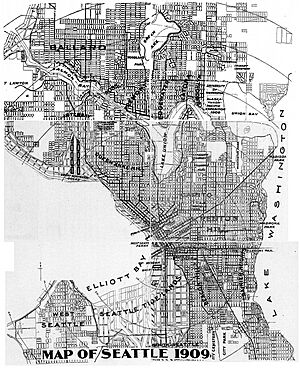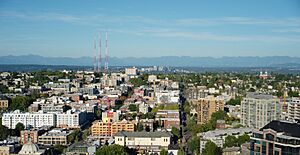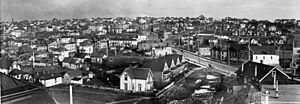Cherry Hill, Seattle facts for kids
Cherry Hill is a neighborhood in Seattle, Washington. It's mostly a place where people live. It's located south of Capitol Hill and is part of the larger Central District. To its north is Capitol Hill, to its south is the International District, and to its west is First Hill. Cherry Hill is bordered by 14th Avenue on the west, 23rd Avenue on the east, East Madison Street on the north, and East Yesler Way on the south. This area also overlaps a lot with a neighborhood called Squire Park.
What is Cherry Hill's Geography Like?
Cherry Hill sits on a long hill that runs north to south. It's located east of downtown Seattle and First Hill. It's about halfway between Puget Sound and Lake Washington. The northern part of this hill is where Capitol Hill is, and Cherry Hill is on the southern part. East Madison Street acts as the border between these two neighborhoods. The highest point in Cherry Hill is 420 feet above sea level. You can find this spot near the broadcast towers on East Madison Street. Even though Cherry Hill and Capitol Hill are on the same hill, they are considered two of the Seven Hills of Seattle.
How Did Cherry Hill Get Its Name?
The northern part of what we now call Cherry Hill was first known as Second Hill. Later, it was called Renton Hill. In 1870, a section of this area was added to Seattle. Another part, known as the Squire Park addition, was added in 1890. This part was named after Watson Squire, a former governor and senator who owned the land.
The name Cherry Hill was suggested in 1959. A city council member named Harlan Edwards proposed it for a community improvement project. This project covered an area that included Squire Park. The name Cherry Hill then became widely used in the 1960s and 1970s. Buildings like the Cherry Hill Community Center also used this name. In 1986, the Squire Park Neighborhood Council was formed, bringing the name Squire Park into wider use. When Providence Hospital became Swedish Medical Center Cherry Hill in 2007, the Cherry Hill name became even more popular.
From 1959 to 1976, the Cherry Hill Urban Renewal Project was Seattle's first big community improvement effort. Over the years, the neighborhood has seen many changes in its residents. At the start of the 20th century, many people from Scandinavia lived there. By the 1960s, it became a mostly Jewish neighborhood. In the 1980s, it became a mostly African-American neighborhood.
More recently, from 2016 to 2020, a tiny house village was set up in the area. This village helped people who needed housing. In 2020, a new tiny house village opened on Cherry Street.
Both the Cherry Hill and Squire Park names are still used today. Cherry Hill is a good new name for the older Renton Hill area. It also shows that the neighborhood is connected to Capitol Hill. Squire Park has a long history and is used in property records. Some people think of them as two different neighborhoods.
What Landmarks Can You Find in Cherry Hill?
Cherry Hill has several important and interesting places. Here are some of them, listed from north to south:
- Temple De Hirsch Sinai: This is a well-known Jewish temple in the area.
- T.T. Minor Elementary School: An important local school for children.
- Spring Street Mini Park: A small park where people can relax.
- Church of the Immaculate Conception: This is Seattle's oldest Roman Catholic Church. It was built in 1904.
- Fire Station #23: This building was remodeled in 1970 to become the Cherry Hill Community Center.
- Cherry Hill Baptist Church: This Protestant Christian Church was unfortunately taken down in 2018.
- Swedish Hospital Cherry Hill Campus: This hospital was first established in 1877 as Providence Hospital. It was started by the Sisters of Providence, a Catholic charity. In 1910, it moved to its current location. In 2000, it became part of Swedish Hospital. This hospital was where the first open-heart surgery in the Northwest United States took place.
- Spruce Street Mini Park: Another small park for the community.
- Washington Hall: A historic building that has been a community gathering place for many years.




